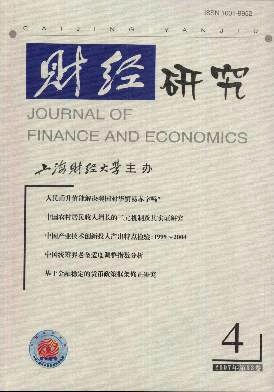人民币升值能解决美国对华贸易赤字吗?——基于1994~2005年间月度数据的贸易弹性分析
财经研究 2007 年 第 33 卷第 04 期, 页码:5 - 18
摘要
参考文献
摘要
文章以1994年1月到2005年3月的月度数据为样本,用ARDL框架下的协整方法,对中美贸易的收入弹性和实际汇率弹性进行了经验分析。分析后发现:第一,我国对美进出口的收入弹性都是显著的,并且我国对美国出口的收入弹性约为我国从美进口的收入弹性的6倍,但是我国对美进口和出口的实际汇率弹性都是不显著的。因此,文章认为人民币汇率对中美贸易没有显著影响,人民币汇率升值将无法改善美国的对华贸易收支。
[1]陈彪如.人民币汇率研究[M].上海:华东师范大学出版社,1992.
[2]戴祖祥.我国贸易收支的弹性分析:1985-1995[J].经济研究,1997,(7):52~62.
[3]厉以宁.中国对外经济与国际收支研究[M].北京:国际文化出版社,1991.
[4]卢向前,戴国强.人民币实际汇率波动对我国进出口的影响:1994-2003[J].经济研究.2005,(5):31~39.
[5]谢建国,陈漓高.人民币汇率与贸易收支[J].世界经济.2002,(9):27~34.
[6]殷德生.中国贸易收支的汇率弹性和收入弹性[J].世界经济研究.2004,(11):47~53.
[7]张茵,万广华.试析我国贸易收支余额波动的成因[J].经济研究.2005,(1):38~46.
[8]朱真丽,宁妮.中国贸易收支弹性分析[J].世界经济.2002,(11):26~31.
[9]Bahmani-Oskooee M.Determinants of international trade flows:The case of developingcountries[J].Journal of Development Economics,1986,20:107~123.
[10]Bahmani-Oskooee M.Cointegration approach to esti mate the long-run trade elasticitiesin LDCs[J].International Economic Journal,1998,12:89~96.
[11]Bahmani-Oskooee M,N Niroomand.Long-run price elasticities and the marshall-lern-er condition revisited[J].Economics Letters,1998,61:101~109.
[12]Bahmani-Oskooee M,T J Brooks.Bilateral J-curve between U.S.and her tradingpartners[J].Weltwirtschaftliches Archiv 1999,135:156~165.
[13]Bahmani-Oskooee M,G G Gowwami.Exchange rate sensitivity of Japan’s bilateraltrade flows[J].Japan and the World Economy,2004,16:1~15.
[14]Bahmani-Oskooee M,O Kara.Income and price elasticities of trade:Some new esti-mates[J].The International Trade Journal,2004,19:165~178.
[15]Bahmani-Oskooee M,A Mirzaie.Real and nominal effective exchange rates for develo-ping countries:1973:1-1997:3[J].Applied Economics,2000,32:411~428.
[16]Carone G.Modeling the U.S.demand for i mport through cointegration and error cor-rection[J].Journal of Policy Modeling,1996,18(1):1~48.
[17]Clarida R.Cointegration,aggregate consumption,andthe demandfori mports:Astructuraleconometric investigation[J].The American Economic Review,1994,84:298~308.
[18]Engle R F,C WJ Granger.Co-integration and error correction:Representation,esti-mation and testing[J].Econometrica,1987,55(2):251~276.
[19]Goldstein M,MS Kahn.Income and price effects in foreign trade[A].R WJones,PB Kenen eds.,Handbook of International Economics[C].Vol.2,Amsterdam:Elsevi-er,1985:1091~1105.
[20]Hooper P,J Marquez.Exchange rates,prices,and external adjust ment in the UnitedStates and Japan[A].P Kenen Eds.,Understanding Global Interdependence[C].Prin-ceton University Press,1995.
[21]Marquez J.Bilateral trade elasticities[J].The Review of Economics and Statistics,1990,72(1):70~77.
[22]Marquez J,C McNeilly.Income and price elasticities for export of developing coun-tries[J].The Reviewof Economics and Statistics,1988,70(2):306~314.
[23]Pesaran M H YShin,RJ Smith.Bound testing approaches to the analysis of level re-lationships[J].Journal of Applied Econometrics,2001,16:289~326.
[24]Stern R MJ Francis,B Schuumacher.Price Elasticities in International Trade[J].London:Basingstoke,1976.
[25]Warner D,ME Kreinin.Determinants of international trade flows[J].Review of E-conomics and Statistics,1983,65(1):96~104.
[26]Wilson J F,WE Takacs.Differential responses to price and exchange rate influencesin the foreign trade of selectedindustrial countries[J].Reviewof Economics and Statis-tics,1979,61(2):267~279.
[2]戴祖祥.我国贸易收支的弹性分析:1985-1995[J].经济研究,1997,(7):52~62.
[3]厉以宁.中国对外经济与国际收支研究[M].北京:国际文化出版社,1991.
[4]卢向前,戴国强.人民币实际汇率波动对我国进出口的影响:1994-2003[J].经济研究.2005,(5):31~39.
[5]谢建国,陈漓高.人民币汇率与贸易收支[J].世界经济.2002,(9):27~34.
[6]殷德生.中国贸易收支的汇率弹性和收入弹性[J].世界经济研究.2004,(11):47~53.
[7]张茵,万广华.试析我国贸易收支余额波动的成因[J].经济研究.2005,(1):38~46.
[8]朱真丽,宁妮.中国贸易收支弹性分析[J].世界经济.2002,(11):26~31.
[9]Bahmani-Oskooee M.Determinants of international trade flows:The case of developingcountries[J].Journal of Development Economics,1986,20:107~123.
[10]Bahmani-Oskooee M.Cointegration approach to esti mate the long-run trade elasticitiesin LDCs[J].International Economic Journal,1998,12:89~96.
[11]Bahmani-Oskooee M,N Niroomand.Long-run price elasticities and the marshall-lern-er condition revisited[J].Economics Letters,1998,61:101~109.
[12]Bahmani-Oskooee M,T J Brooks.Bilateral J-curve between U.S.and her tradingpartners[J].Weltwirtschaftliches Archiv 1999,135:156~165.
[13]Bahmani-Oskooee M,G G Gowwami.Exchange rate sensitivity of Japan’s bilateraltrade flows[J].Japan and the World Economy,2004,16:1~15.
[14]Bahmani-Oskooee M,O Kara.Income and price elasticities of trade:Some new esti-mates[J].The International Trade Journal,2004,19:165~178.
[15]Bahmani-Oskooee M,A Mirzaie.Real and nominal effective exchange rates for develo-ping countries:1973:1-1997:3[J].Applied Economics,2000,32:411~428.
[16]Carone G.Modeling the U.S.demand for i mport through cointegration and error cor-rection[J].Journal of Policy Modeling,1996,18(1):1~48.
[17]Clarida R.Cointegration,aggregate consumption,andthe demandfori mports:Astructuraleconometric investigation[J].The American Economic Review,1994,84:298~308.
[18]Engle R F,C WJ Granger.Co-integration and error correction:Representation,esti-mation and testing[J].Econometrica,1987,55(2):251~276.
[19]Goldstein M,MS Kahn.Income and price effects in foreign trade[A].R WJones,PB Kenen eds.,Handbook of International Economics[C].Vol.2,Amsterdam:Elsevi-er,1985:1091~1105.
[20]Hooper P,J Marquez.Exchange rates,prices,and external adjust ment in the UnitedStates and Japan[A].P Kenen Eds.,Understanding Global Interdependence[C].Prin-ceton University Press,1995.
[21]Marquez J.Bilateral trade elasticities[J].The Review of Economics and Statistics,1990,72(1):70~77.
[22]Marquez J,C McNeilly.Income and price elasticities for export of developing coun-tries[J].The Reviewof Economics and Statistics,1988,70(2):306~314.
[23]Pesaran M H YShin,RJ Smith.Bound testing approaches to the analysis of level re-lationships[J].Journal of Applied Econometrics,2001,16:289~326.
[24]Stern R MJ Francis,B Schuumacher.Price Elasticities in International Trade[J].London:Basingstoke,1976.
[25]Warner D,ME Kreinin.Determinants of international trade flows[J].Review of E-conomics and Statistics,1983,65(1):96~104.
[26]Wilson J F,WE Takacs.Differential responses to price and exchange rate influencesin the foreign trade of selectedindustrial countries[J].Reviewof Economics and Statis-tics,1979,61(2):267~279.
引用本文
金洪飞, 周继忠. 人民币升值能解决美国对华贸易赤字吗?——基于1994~2005年间月度数据的贸易弹性分析[J]. 财经研究, 2007, 33(4): 5–18.
导出参考文献,格式为:





 7381
7381  490
490

